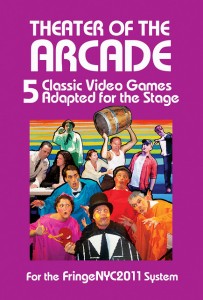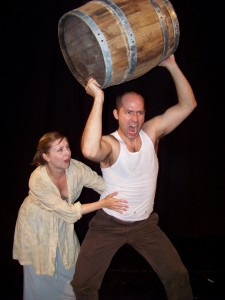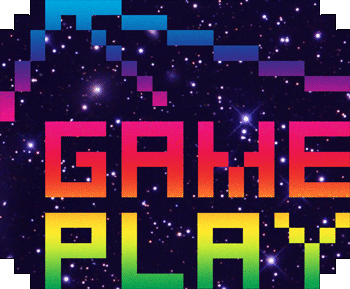Classic Games Adapted For Stage In “Theater Of The Arcade”
Posted on August 10, 2011 For decades, Atari Asteroids has been calling out for dramatic adaptation, and Jeff Lewonczyk has responded with his play, “Theater of the Arcade.” The work is five scenes inspired by classic video games, each written in the style of a different well-known playwright.
For decades, Atari Asteroids has been calling out for dramatic adaptation, and Jeff Lewonczyk has responded with his play, “Theater of the Arcade.” The work is five scenes inspired by classic video games, each written in the style of a different well-known playwright.
The official synopsis reads: “A violent brute holds an innocent young woman captive and attacks anyone who dares approach. A glutton eats everything in sight while running away from the ghosts that haunt him. A lone survivor forges a peril-ridden path towards a lush refuge he can never reach. Are these the plots of classic video games, or are they searing narratives of modernist drama?”
The Asteroids scene is entitled “Magdalene Magellan Mars,” and channels the voice of David Mamet. “Theater of the Arcade” was originally part of the 2010 Game Play festival, and is about to have its second staging in the 2011 New York International Fringe Festival, with 5 performances from August 13-27.
We spoke with Jeff Lewonczyk to find out more.
Atari Asteroids: What was your inspiration for Theater of the Arcade?
Jeff Lewonczyk: The Brick has been doing this video-game theater festival called Game Play for the past few years. Early last year, when we were discussing programming for the second (2010) edition, I casually blurted out that I thought it would be fun to do a play that actually treated the narratives of old-school video games as if they were the stuff of serious theater. Gyda Arber, the festival’s producer and curator and a good friend, immediately volunteered to direct it if I were ever to write it. So I kind of did it on a dare to myself.
As I worked more on each of the pieces, I grew more and more intrigued by what went into developing something essentially non-narrative into a story format. In order to make it work to the fullest extent, I realized that each of the plays needed to have an analogue in the theater world, and so I ended up using each game to parody a specific playwright with a highly recognizable style. The result ended up being a weird hybrid, which satisfied both gamers and theater fans, but in very different (though often highly overlapping) ways.
AA: What drew you to the games that you ended up adapting?
JL: Mostly, they were the games I grew up with. I was never a skilled gamer per se, but I had a friend who had an Atari 2600, and going over there and playing it – or, more likely, watching him play it – was like a window onto another realm. Also, these games were just in the air at that time, pop-culture wise – cartoons, cereal, novelty music, you name it. I was always attracted to the iconography of those early games, and they retain a high nostalgia value for me. However, I think a reason I found myself drawn to adapting those, as opposed to later-generation games, is that they’re wide open to interpretation. Like, what kind of story is Pac-Man, really? Who the hell is this yellow guy, and why is he consigned to a haunted maze where all he can do is run around and eat? Or take Asteroids – who exactly is flying this ship, and why is he (or she?) trying to blow up all these space rocks? There were a lot of possibilities.
AA: What can you tell us about the Asteroids play, “Magdalene Magellan Mars?”
JL: Well, I don’t want to give TOO much away, since we’re about to open in a remount of Theater of the Arcade at the New York International Fringe Festival on August 13, but I will say that it’s about the question I asked above: who’s flying these ships, and why? It’s essentially a power struggle between two pilots, an old pro and a younger hotshot, who are both called in for questioning to find out which one of them is shirking his duties and not blowing the asteroids into small enough pieces. There’s also a sexual element, since the interrogator is female, and there hasn’t been a woman on their base in years. Excitement!
AA: And what’s the connection between Asteroids and David Mamet?
JL: The truth is, it took me a while to fall into that combination. I had known from the beginning that I wanted one of the pieces in the show to be one of the outer-space games, but I couldn’t decide between Asteroids, Missile Command or Space Invaders. When I started thinking about playwrights, I realized that Mamet would be a great choice, since blowing things up is an inherently masculine activity that brought to mind the testosterone-fueled real-estate world of Glengarry Glenn Ross. The clincher for Asteroids, though, was nearly abstract – Mamet’s intentionally choppy and fragmented language reminded me of the ever-smaller pieces of detritus that result from blowing up asteroids. The combination of fragmented space rocks, fragmented language, and the fragmenting of human beings when they’re isolated on a remote base on another planet destroying things for a living all came together into a single storyline.
AA: Brilliant. Now beyond your background knowledge, growing up around the Atari 2600 and reading plays, what sort of new research did you do in creating this piece?
JL: I played the game online quite a bit, and I read up on its history via Wikipedia and a few other gaming history sites. The truth is, though the piece is riddled with references to the game play, there were some things I wasn’t able to incorporate without being awkward or contrived. The UFO, for instance, doesn’t make an appearance, nor does the hyperspace function. I definitely had some purists grouse about that to me after the show, but what can you do? It’s a work of fiction – sometimes you need to sacrifice details for the big picture.
AA: Have you done anything else like this play?
JL: Not exactly. Everything I’ve ever worked on has had elements of pastiche, but not to the extent of doing direct parodies of existing playwrights or adapting existing entities into a new form like this. Still, I’m in love with the idea of reinventing the things we see in our culture and the world into new terms and seeing where the transformation leads, and this show definitely falls into that. I’ve had people suggest that I could just keep churning out short plays based on games, but I feel like I’d run out of truly archetypal games rather quickly, and that it would lose its luster fast. That being said, I do still kind of want to do Space Invaders as a big musical dance number, or a Shakespearean Joust, or – and this is the one that I actually spent a while trying to accomplish for the original run – a Chekhovian take on Tetris. So maybe I’ll return to the idea at some point – only time will tell.
Video Game Theater Festival in Brooklyn
Posted on June 30, 2011On July 7 – 31, 2011, the Game Play festival is back, bringing the ideas, themes and technology of video games into a live theatrical setting. It’s being held at The Brick Theater in Williamsburg, Brooklyn, which just wrapped up its Comic Book Theater Festival in June.
There are plenty of exciting performances on this year’s lineup, ranging from monologues to avant-garde video projections. Plus, there’s an opening night party, chiptune dance party, installation, karaoke, and geek burlesque, all right around the corner from Barcade. Visit their website for full details and schedule.
We spoke with Chris Chappell, associate producer of Game Play, to find out more.
Atari Asteroids: The Game Play festival is now in its third year. How did it first come about, and what was the idea behind bringing video games and live theater together today?
Chris Chappell: The festival originated in the summer of 2009 with the happy confluence of three shows that happened to be going up around the same time and had developed independently: Sneaky Snake Productions was premiering a play entitled Adventure Quest based on old Sierra/LucasArts adventure games; The Fifth Wall was mounting Suspicious Package:Rx, in which the audience were effectively the performers and moved from location to location, guided by iPod-style devices; and Eddie Kim wanted to showcase some of the work he was doing with his theater students in Connecticut, which entailed “performances” in gaming environments such as Halo and Grand Theft Auto. All three used elements of gaming in radically different ways, and once we realized that, the idea of yoking them together in a festival setting was a no-brainer.
AA: Hollywood has adapted video games into blockbuster movies. They’re very good at making things blow up and look really cool. But what advantages do you have in dealing with video games in an independent theater?
CC: Hollywood’s approach to porting games to movies is basically to appropriate the plot elements and characters of a given game and structure a fairly conventional action film around them. This process necessarily drains away most of what made the game a game in the first place–it’s just an extension of a franchise, without regard to the actual experience and unique aspects of the game. Theater, and particularly indie theater (a game-derived project on the scale of Broadway’s Spider-Man would probably take a more movie-like approach) works in a totally different way–it can actually draw on gaming to play with theatrical and narrative forms, coming up with new ways of storytelling. This in part because of the intimacy afforded by live theater; in part because of indie theater’s openness to experimentation; and in part the fact that the scale and nonprofit model of these projects means they don’t have to aim at a broad swath of the 18-35 male demographic.
AA: How have people responded to the festival, both in terms of the audience and the work you’ve seen?
CC: The response has been really gratifying. The gaming aspect is obviously a hook of sorts, and we haven’t been shy about using that to get the attention of folks outside the usual independent theater circles in New York. In fact, gamers in some ways seem a lot more open to what we’re doing; the theater press in NYC sometimes doesn’t seem to quite know what to do with these shows, while we’ve gotten a lot of coverage from gaming media. (In fact, our coverage in the New York Times last year came from the gaming editor, not any of the theater staff.) Of course, in some quarters there’s been some understandable skepticism from folks who suspect this all just a bunch of hipsters who see this as trendy and don’t really get videogames. When they come out and see what we’re doing, though, I think most of them get that these are sincere and credible efforts in fusing the two forms that can yield some really innovative results. When we get people in the door who aren’t part of the usual theater scene, we know we must be doing something right–and naturally, we hope that Game Play can serve as a kind of gateway drug for the other theatrical experiments we’re undertaking.





